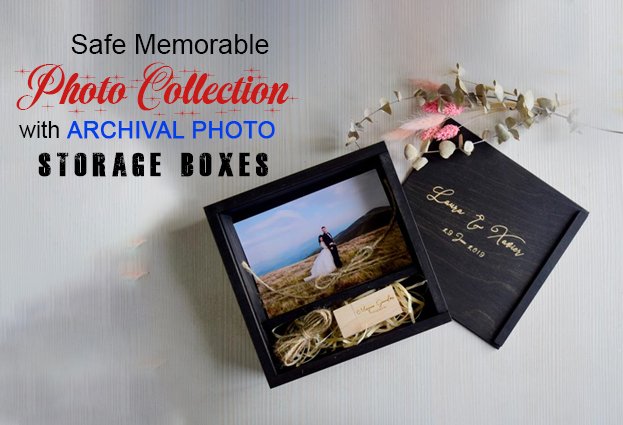Acid-free picture boxes continue to be the best archival storage choice for photographic prints, because of their ability to block dirt, dust, and light. Sorting and organizing images while shielding them from the elements is simple. Photos may either be stored flat or on the side, grouped into groups inside transparent individual enclosures, and isolated within the same collection from potentially hazardous acidic materials. You want to organize your pictures in envelopes or Photo Storage Boxes to protect their condition, whether you choose to shop at home or in your storage unit. To separate prints on the inside, an ideal container for storing printed images would have a sealed, water-resistant exterior, such as plastic, and soft but rigid dividers. Using the imagination, with that as a basis! You might prefer to use envelopes or file folders as your dividers and to include them in a plastic tote or file box. These are typically things that you would have on hand.
How Pictures can be Organized in Boxes or Envelopes:
Regrettably, if you want to secure your photographs, the process would entail more than just throwing them into protected Photo Storage Boxes. Here are some things to keep a close eye on when you pack pictures away:
- Flat:
To allow your images to remain flat, use stiff, flat materials and containers.
- The right fit:
With your boxes and your prints, make sure the fit is correct. The best way to harm and doge them before they’ve even made it to storage is to stuff photos into a package that is too small in length or width.
- Only enough to fill the boxes:
It can have the same effect of stuffing too many images in one box as using a box that is too small. Leaving too much space in a box will cause objects to change in transport on the flipside. Fill it with non-acidic tissue paper if you have additional space.
It is helpful to have non-acidic dividers:
While it may sound meticulous, it may save them in the long run by putting a sheet of paper or some form of divider between images, particularly if your images overheat or come into contact with water. To keep things flat and in place, the stiffer, the better when it comes to dividers.
An Archival Photo Storage Boxes is an image storage kit that was designed to have enduring usefulness. Generally, on a cheaper storage medium, archival photos are held off-line. Typically, archival images are of higher accuracy and sensitivity than the digital image given to the user.
Safe Environment:
As long as archival photo albums are bought, photo albums can be a perfect way to manage your photography collection. Many online archival stores have acid-free, lignin-free photo albums and have passed the P.A.T. These albums come in various colors, and some also have different pattern decorations. You’re ready to place your photos in an album until you have an archival photo album.
It is necessary to store these albums in a secure environment until the photo album is completed. Picture albums should be kept lying down on their ends and not standing on them. It may place a strain on the binding by storing photo albums on their ends, causing it to break down and ultimately fail. When using photo albums, it is essential to note that if stored improperly, the pages or sleeves can sag or become deformed. Before you put the images in the sleeves that go into the folder, make sure that the people, houses, locations, etc. that are in the photographs are marked.
Preserving photographs in boxes:
A brilliant archival technique is also to store images in photographic frames. It may be a little bit expensive to buy picture sleeves and archival boxes, but it is well worth the cost. There are picture sleeves of various sizes in the online archival stores, and you should be able to find sleeve sizes to match most of your photos. A personal choice is an archival box that should be used. Archival Photo Storage Boxes that are exclusively for photos can be bought, or you can use a Hollinger container. It is essential to remember that you will also need to use archival file folders if you plan to use Hollinger boxes so that the photos will be kept flat and well protected. These boxes can be stacked on shelves, one on top of another, until the photographs are in their sleeves and stacked in the picture boxes. Again, store these boxes away from temperature and pressure fluctuations in a cold, dark, and dry spot.
Storage Conditions:
Even though images are made and printed on paper, they comprise both ink and pigments that, if not properly preserved, will degrade over time. For that purpose, if you want them to last and maintain their quality for decades to come, storing images in the right set of circumstances is essential. The conditions under which you can keep old photos are connected to three key factors.
1- Temperature:
Temperatures of storage above 75 degrees Fahrenheit can interfere with the chemicals used in image processing, resulting in discoloration. When it refers to photo storage, the colder it is, the more remarkable.
2- Humidity:
It’s not just possible flood regions that you have to think about, but also levels of humidity.
3- Illumination:
Light can trigger a fade of photographs. If you can’t enclose your prints, be sure you’re keeping them in the dark spot.
Plastic Storage Boxes:
Plastic is often criticized, but one thing that you can do is store your old memories well. There are smaller containers inside the package that carry around six images each. This plastic box is secure to use and has around the house made of B.P.A. and other chemical-free materials. Rounded corners secure your images from any possible harm.











